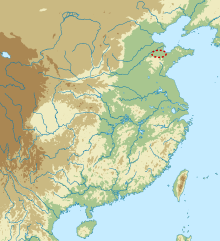
Back Cultura de Houli Catalan Houli-Kultur German Culture de Houli French Cultura di Houli Italian 後李文化 Japanese 허우리 문화 Korean Houlikulturen NB Хоули (культура) Russian Văn hóa Hậu Lý Vietnamese 后李文化 Chinese
 | |||||||
| Geographical range | Shandong | ||||||
|---|---|---|---|---|---|---|---|
| Period | Neolithic China | ||||||
| Dates | c. 6500 – c. 5500 BC | ||||||
| Type site | Houli | ||||||
| Major sites | Yuezhuang | ||||||
| Followed by | Beixin culture | ||||||
| Chinese name | |||||||
| Chinese | 后李文化 | ||||||
| |||||||
The Houli culture (6500–5500 BC[1]) was a Neolithic culture in Shandong, China. The people of the culture lived in square, semi-subterranean houses. The most commonly found artefacts at Houli sites are pottery and stone tools.[2] Jade artefacts and bone, antler, shell tools were also found at Houli sites.[2] While the remains of domesticated dogs and pigs in the early stages of domestication were found at some sites associated with the culture, the people of the Houli culture relied mostly on hunting and fishing.[2] The remains of rice, broomcorn millet, and foxtail millet were discovered at Houli sites.[2]
The type site at Houli was discovered in the Linzi District of Shandong and was excavated from 1989 to 1990. The culture was followed by the Beixin culture.
Currently, about a dozen sites have been found to be associated with the Houli culture. Five sites from the culture have been excavated so far.[3] Aside from the type site at Houli, excavations have also taken place at Xihe, Xiaojingshan, Qianbuxia, and Yuezhang.[2]